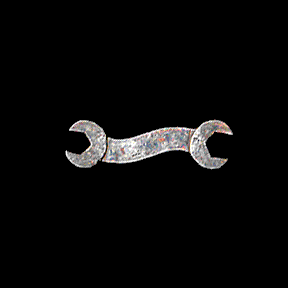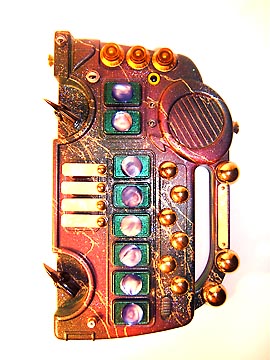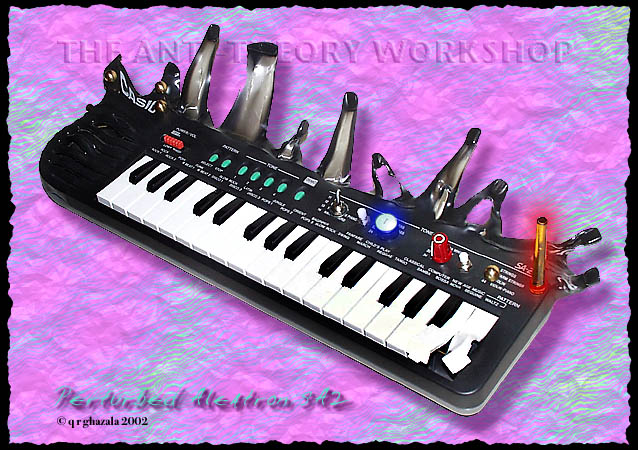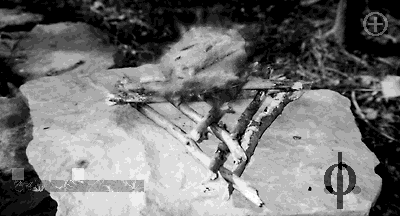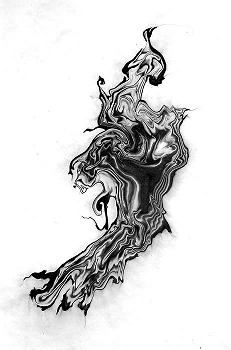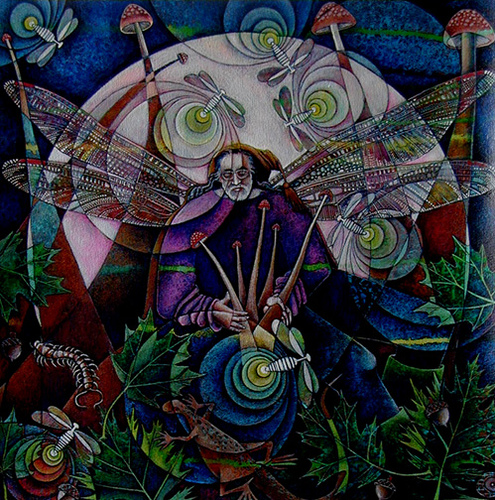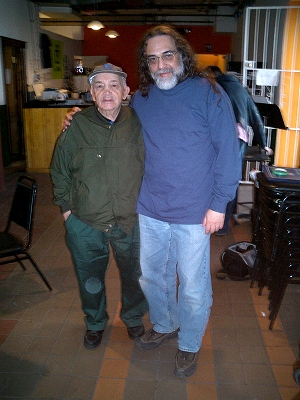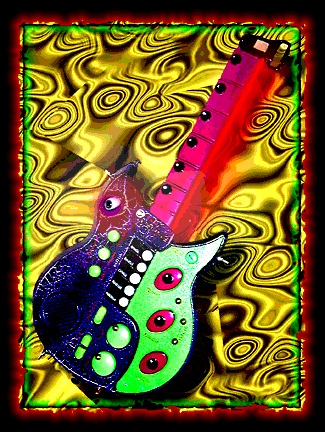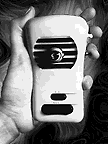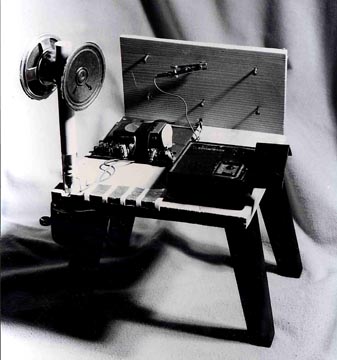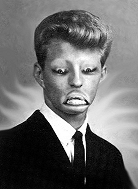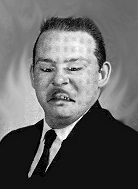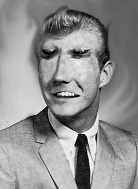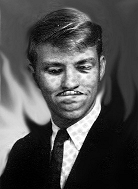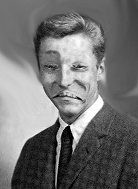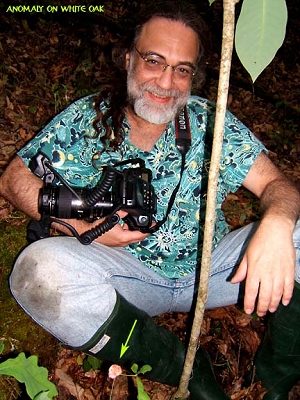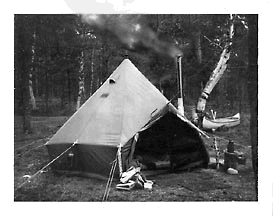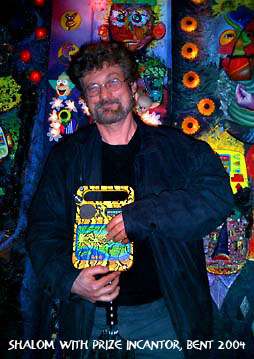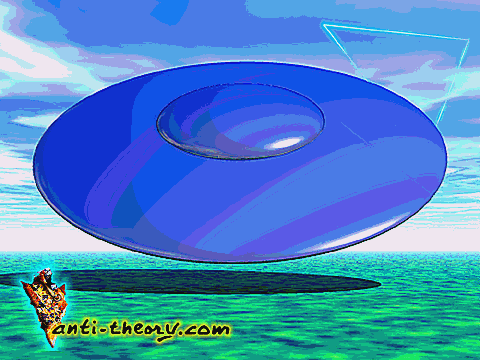|
Ghazala interview: Taz, Germany – 3.16.06 |
||
|
|
||
|
This is just a fun name for the new
creature one becomes when one plays a body-contact instrument – an
instrument that conducts electricity through the player’s flesh via
touch-contacts connected to the circuit. |
||
|
|
||
|
You say alien instruments should be played by a different musician? What kind of musician? An alien one?
Ideally, yes – an alien one. Or at
least someone who’s mind has not been set in its ways concerning what
music is or isn’t. My point was that someone expecting the musical
keyboard placed before them to present the pitches of the equal tempered
scale will be sorely disappointed if faced with a circuit-bent instrument
whose “black & whites” no longer do so. If you expect to hear “C” when
pressing “C” on the keyboard, but instead a train of unknown chance tones
result, well… it’s broken, right? |
||
|
|
||
|
What is for you the difference between noise and music? Difference? To me? Or to a cat? Or a cricket? To a cricket, I suspect, Mozart and moped may be equally compelling. To a cat, the same, though it would add the cricket to the list. To me, it seems there is a psychology of sound that struggles to thrive within the constraints of common music trappings, things such as the equal tempered scale, repetitive rhythms, and endless well-established formulas. These models, the formulae carpeting most radio air time, have convinced us that music is the stuff that gold records are made of. And this is true, in a very limited way. But such music might just as well serve as a schematic to unravel the underpinnings of constructed sound, an x-ray that suggests endless new fields. Sound and color, each a wave-form phenomena, each highly emotive, are treated very differently between painting and music. While any color is accepted upon a painter’s canvas, just try that with sound! And here is where your question comes from. We simply have not yet liberated either the sounds or the minds to hear them, these sounds beyond the orchestra’s instruments, and in this shallow embrace we miss viable sonic textures not only routinely, but passionately. Witness: “That’s not music!!” To my mind, sound constructed by chance (let alone noise composed by humans) can be as emotionally stirring as the constructs we know “music” by. In the end, every sound elicits an emotion. Composers and artists cannot miss this point – the tools are too important. Once I realized that every stream of sounds is a poem and a sculpture, regardless of source (whether quintet or countryside), things crystallized immediately. Everything that makes nose is music, sculpture, poetry. Everything. At least until we decree that color be banned from canvas. Could you explain me your found-object placement art? I know that all creatures aesthetically interpret their environments. I know that fish jump for joy, that birds sing for pleasure, and that dogs grin. How can one not leave them art? Woodland creatures are very sharp. This is a survival thing. They’re very keyed into their environment. When I create a mobile to leave in a pine grove, or assemble an interlocking keystone sculpture, this is a break in the white museum wall: a picture at an exhibition. |
||
|
|
||
|
You are a strange-book collector, I read. Which is you strangest book? I have books so strange that they dare mention. So I won’t. But in the general sense I admire the journals of fringe scientists. Or the fringe escapades of known scientists (Tesla, Royal Rife, etc.). You know, much of our world is undiscovered. The indicia of lost elements is important. This indicia can be read about in the journals of travelers who witnessed the unexplained. I find these journals fascinating. If I were to hand-write a journal, cover-to-cover, is this a book? Or need it be published to become a book? I don’t see this divide. So a madwoman’s journal, found by moonlight and set out with the trash, is perhaps my rarest, strangest book. Her poetry, a diary conveyed in surreal and haunted metaphor, read under the same moonlight it was found, is a favorite rare book of my library. Where does your fascination with chance as a mode of art come from? I don’t really know. I like the surprise in chance, and recognize chance as a powerful dynamic of creation. |
||
|
|
||
|
You seem to have done almost everything in Art. What projects do you have for the future? I hope to sit against trees, next to small fires, and read good texts, play instruments, write a few books, and cook good food for friends.
Lab-wise, right now I’m working on a
re-release of the planet’s first Incantor (circuit-bent Speak & Spell)
music, new material added. Entitled “There is a Secret Garden,” the album
will be on two 12” white vinyl records (audiophile quality heavy vinyl)
and will be illustrated through ten paintings by artist Samantha Mindrum-Logan.
Updates will be posted on my website, anti-theory.com. |
||
|
|
||
|
New instruments are always in development. And I should mention that I’m currently studying moths. Your lessons What kind of people takes lessons with you? (Profession, age, interests...) Everyone. This has always been my audience. Any “circuit-bent” teaching out there comes from me and my processes, whether the practitioners know directly of me or not (I established and named “circuit-bending” long ago, starting back in 1966; many people use the practice now to teach the art). In this sense, the class for little kids that MIT offers is a class for my students, 6,7,8 years old. People in their teens are doing it. College professors teach it to their students. Professionals and laymen, artists, explorers, scientists, theorists; all are benders.
But you’re asking me about my
apprenticeship program and my public workshops. Though the average age of
people attracted to the art might be 15 – 25 year-olds, one of the most
interested people attending my workshop in New York City was a
super-intelligent gentleman in his eighties. |
||
|
|
||
|
In my apprenticeship program, students range from a U.S. Navy warship Commander to a North Korean art student and everything in between. Mostly, people understand that circuit-bending is empowering. It’s a simple way to hear new sounds, discover/create unique instruments, compose new music, explore a new field in music, and to some, launch a new career as an electronic instrument designer. After all, this is the first fabrication system that invites anyone and everyone into electronic design, overnight, regardless of their experience (no understanding of electronic theory is needed to circuit-bend – soldering is baby-simple as I demonstrate in my book). It only takes an instant to teach people how to design an instrument no one else has yet heard – a unique instrument that exists nowhere else in the universe. |
||
|
|
||
|
Tell me anecdotes of your lessons (strange things, unusual discoveries, etc.). Unusual discoveries are non-stop in circuit-bending (each circuit is a possible gold mine of yet-to-be-discovered sounds). Strange things abound. Entering this world is like landing on another planet. An alien fauna surrounds you. Contemplating the BEAsape animal was fun, needing categorization as it did. I mean, naming new species is serious business, and a task usually assigned to biologists. But someone had to do it! As covered in my book, a new terminology needed to be created to communicate the new ideas anchoring bent philosophy. Lesson after lesson are reflected here, in original terms such as circuit-bending, the threshold of invention, the coconut concept, living instrument, clear illogic, theatric listening, and others. Realizing the vast differences between hacking and bending (the difference between know-how and chance) sets one to pondering. New fields always find a voice through invented language. Designing instruments for Tom Waits’ performance of Alice in Wonderland in Germany was a blast – until an instrument was hung-up in customs. |
||
|
|
||
|
Designing for the Rolling Stones was a gas, gas - gas! We covered their tunes in my early bands (1960’s). Keith enjoys experimental musical instruments. The opportunity to build instruments for Mick and Keith was nice, a thanks for the good times their music helped create long ago. I finished the instruments in “Pink Champagne,” the color of the Ludwig drums I learned to play while listening to The Stones in my teens. Lots of these kinds of things, due to circuit-bending’s influence in music. Recently I was invited by Nine Inch Nails to a performance. Trent and Allessandro are into circuit-bending. It’s always fun to talk with the bands. Simon & Garfunkel, the same. Very different bands! But that’s how it is. Bending is a frontier recognized by musicians everywhere. However, the now-classic point in bending’s history, early history, was that of playing in the wrong place at the wrong time. Neither the band nor my instrument would survive the evening unharmed. To appreciate the circumstance of this engagement, one must recall the era of the American 1960’s. In my (very tiny) corner of the world, society was divided between two “camps.” The most interesting (and certainly most colorful, worldly and musical) camp for my age group was the hippie movement. This meant I’d just enlisted in a tribe whose “colors” were a giant bull’s eye indelibly painted upon one’s back. This painting, attractive to the other nine-tenths of society, was the price of admission. That other nine-tenths of society was in attendance, and was in fact our audience, when we took the stage one evening. This was a stage where sermons were usually served, the stage of a small Christian church. Our invitation was the same invitation that went out neighborhood-wide: If you have a band, you’re welcome. Well, we not only had a band, but we also had planet earth’s first circuit-bent instrument.
|
||
|
|
||
|
Alas – our line-up didn’t include Blue Suede Shoes, Hound Dog, the theme from Rawhide or any of the other requests shouted from the audience. And what we did know, tunes like Alice’s Restaurant and Light My Fire, were but fuses leading to the powder keg - “Don’t you guys know no music at all? Elvis! Elvis! Elvis!” But it was when I brought out my first circuit-bent instrument, and sent it squealing into the big Fender and Vox amps, that the audience went into melt-down. First there was silence – the kind of silence that falls over an audience at a magic show, the kind that accompanies disbelief. But heads were now turning to each other, sharing a mounting outrage that hippies could be making this kind of noise in their neighborhood. That they were expected to put-up with such an instrument making such a sound – it didn’t even have strings! Clearly, we somehow were bashing Elvis, and his fans would not stand for such. Before this last song was over, our “fans” had blocked the doorways, and had become a truly ugly bunch.
|
||
|
|
||
|
In a moment we realized it was the instrument they were after. Though I tried my best to protect it, it was smashed beyond the possibility of repair by the time we fought our way to the van parked outside. No, we didn’t play there again. Nice little lesson in experimental music, eh? I salvaged the circuit from the instrument, even though it looked run over by a truck, and created a new instrument, even better than the first. And this time, armored against an irate public: everything was now contained within a lidded wooden box. I learned to slam the lid shut at even the slightest whiff of hair tonic, and could snap it closed by the “v” in the sentence “Love Me Tender.”
Another memorable, and much less
injurious, incident occurred when guru Sri Chinmoy dropped by the
workshop. I’d invited an Indian-speaking friend over as interpreter.
Unfortunately, he was in awe of Sri Chinmoy and remained speechless
throughout. Later he informed me that Sri Chinmoy is considered a God by
many, and confessed he didn’t really believe Sri Chinmoy would show up. He
thought I was kidding. |
||
|
|
||
|
In flowing peach-colored robes, Sri Chinmoy sat in the workshop and watched me play one of my Photon Clarinets. Since these instruments are played without touching, my hands were up in the air high above the instrument so as to cast shadows upon the musical sensors below. Sri Chinmoy looked amused. Watching my hands, he asked, “Is the music up there?” Sri Chinmoy is a guru, and it’s a guru’s job to enlighten. But I’ll never really know why he asked the question. All I know is that I then thought about it, looked up at my hands, and realizing this truth, said, “Yes, the music is up there.” Sri Chinmoy, now looking me in the eye, nodded a silent “yes” in confirmation. If anyone can do circuit bending, how do you recognize the talented from the untalented students? Well, anyone can paint. How do you recognize a good painter? Talent often means originality, vision, and execution. It means fine communication. Artistry! All this can be seen in both instrument design and musical composition (just like with any instrument: design and performance bring critical acclaim to instruments, circuit-bent or not). If one can’t get past the new sonic palette of bent instruments, recognition of such artistic tenets will be difficult. But as one begins to appreciate music and sound as sculpture, well-designed instruments and well-composed music become evident. Timbre, dynamics, orchestration, development… all the processes of sensitive composition are available to the bent artist/designer/composer. How old are you? I was born in 1953, at night, during an electrical storm. I think I’m 52 right now. But I’ve lived several lifetimes already. I may be 552 for all I know. Perhaps I’ve worn too many hats. What did you study? Study is an ongoing thing for involved people. Formally, as a young child, I was directed into painting, classical piano, and theater. But I was already studying (and naming) everything in the woods behind my house, poking the innards of radios, using my grandfather’s tools, printing in my mother’s photography darkroom. I’ve studied everything, or at least it seems that way. I‘ve always studied. But on my own. This pattern developed when I realized in grade school that they didn’t teach what I wanted to learn. And thus was launched my dismal scholastic dossier. |
||
|
|
||
|
Is Qubais Reed Ghazala your real name? Where does it come from? What does it mean? That’s my real name. It’s Middle Eastern, though I’m American, born and raised to the tune of the ice cream truck in the culture-void of the Midwest. The name is, I realized late in life, a poetic assemblage, even tribal, traditionally conveying insight, mystery and power. It’s meant to be lyrical, and touches upon traditions of poem (the ghazal) and legend (Mt. Abu Qubais, the “first mountain made” and a magical escarpment said to have “split the moon”). The “Reed” part might be there for intermission’s sake – to allow one to come up for air. Reed became my first name in school. This, perhaps, was an act of kindness, as Reed requires less speculation. And then there’s the gazelle, an antelope of the genus Gazella. Ghazala, in the strictest sense, is said to be derived from this often endangered and in some species, extinct, animal. On my mother’s side of the family, I’m German. The blood lines were Emmert and Rehm. Cincinnati has a historic German community of course; the Emmerts were Cincinnati’s early grain suppliers, always welcome in the city’s beer gardens! What are the advantages and disadvantages of being self-taught? For the lifestyle I like to lead, one that admits willingly the lack of cocktail talk anchoring professional/academic circles, there are no real disadvantages. I dropped out of art school to get away from this cycle, and from the rehashing of old ideas. Institutions need these commonalities – they measure “progress.” They provide a knowledge base that all students are evaluated by. What would schools do otherwise? Diplomas need to be justified. I understand this as a teacher – I come from a family of teachers. The institutions are great exposure facilities. But I also see a frustration in creative people over-dosed on curricula, a curricula that standardizes experience and tends to shave the individualistic edges off of students. Many artists are breaking away from not just the institutions, but from the whole cycle of surety these ventures represent. People are thinking more about fitting into their creative soul than fitting their creative soul into academia. When I need a certain fact, I go find it. I’ll use the same books as my contemporaries – the texts from the institutions I traded away.
|
||
|
|
||
|
But being self-taught allows you to come into yourself via your own thoughts. Originality is difficult to teach, but easy to fall upon. I find it better to just set the stage and make the mistakes, the original observations and personal conclusions – these lead to the heart of originality. Tell me about your self-exile periods in the wilderness.
The American Indians have special
places in the woods referred to as “medicine spots.” They are places of
insight and healing. Places to achieve balance. The whole forest is this
to me. In it I see everything in balance. |
||
|
|
||
|
When I exile myself I do so to recharge. And I stay as long as this takes, and I love it. Days, weeks, more. Until the snow is too thick, the mosquito has grown too fat on my blood, or I’m needed back home. Contrary to internet rumors, yes I do have a home. No, I don’t live in a tree (but I’m working on it). The mail art in you webpage is out of order now, and you use a (modified) German speech to excuse you. Why German? My website, anti-theory.com, was created by Nebulagirl (AKA Dr. Cynthia Striley, LT CDR), herself of German descent. She had just traveled to Germany to see a total eclipse of the sun (1999), and was brushing up on her German. With translations on her mind, and liking the language, she excused my hesitation to post the images in this way. The mail art gallery is still on hold. I’m awaiting approval from some of the recipients named on the packages. Maybe I’ll post the rest, but the best examples are yet in limbo. And so it goes. Tell me about the circuit bending festival in New York 2004. Would you have other this year? That festival was created by The Tank, a very forward-looking gallery, then on 42nd Street. It happens every year. I hold a Pink Moon celebration in the deep woods at that time, making my attendance in New York very difficult. But when I was able to get there in 2004 things were just wonderful!
|
||
|
|
||
|
I’m used to being a recluse. I like that. Being a big-shot in NYC was another world. Especially since I know how long and methodical my road has been – the first 25 of these 39 years were without any recognition at all. It was sheer curiosity that led me to explore this space non-stop. I feel more like a laborer than an icon. I hope to some day begin a yearly circuit-bending seminar. This would involve a lodge or cabin rental, in a woodland setting, and span a weekend. Workshops would be the focus. But galleries and performances would run throughout. I do have a great place in mind, and things are possible. But these are busy times and I’m spread dangerously thin. I’d call 9-1-1 except that I bent the phone. What do you think of your imitators like the people of circuitbenttoys.com? I don’t know that these benders are always imitators. Was Renoir a Monet imitator? Or van Gogh? If people do original work within a field (impressionism, or bending, or whatever) it makes the field stronger, often better understood. If an art is successful, it will attract many explorers. Since the release of my book, Circuit-Bending, Build Your Own Alien Instruments, by Wiley & Sons, an explosion of bending sites have cropped-up. If people do good original work, why not promote? Long ago, having studied inventing (even a college course!), and as an avid inventor, I’m familiar with the legal battles involved in the “intellectual property” game. It’s not for me. At least not to be applied to what I see more as an art form than a business venture. I presumed that others would build and sell instruments based upon my teachings. And I also assumed that there would be people who’d blatantly knock-off my instruments and present them as their own discovery/product. I was right on all counts. Circuit-bending is powerful and can change many things. But it’s not powerful enough to change human nature. To be sure, there are people who even claim to be originators of circuit-bending, pretending as though my history doesn’t exist, that I didn’t name the field, and that their own work isn’t a trickle-down of the bending pool, a body whose nomenclature and techniques are verifiably traced to me. But I’m well-documented, and I’m content to let the historians sort things out in the end. My advice to artists is simple: be original and give credit to your mentors. An artist’s career is swiftly self-destroyed by knocking-off other’s work. Avoid.
|
||
|
|
||
|
No other movement in music history has had such an impact upon the planet’s experimental instruments. Hundreds more are produced every day via bending. This causes speculation about the nature of music as more and more people grapple with the question: “what’s music?” And questions always lead to answers. Do you sense that I feel music is misunderstood? Of course you do! So I’m glad to see so many people exploring this new art. I hope they’ll become as intrigued as I’ve been, and recognize the power of this peculiar new realm of music. Persons interested will enjoy visiting the free how-to at anti-theory.com to start their own adventure in circuit-bending. That’s the how-to that started the entire movement, structured to invite anyone into the zoo.
|
||
|
|
||
|
|
||
